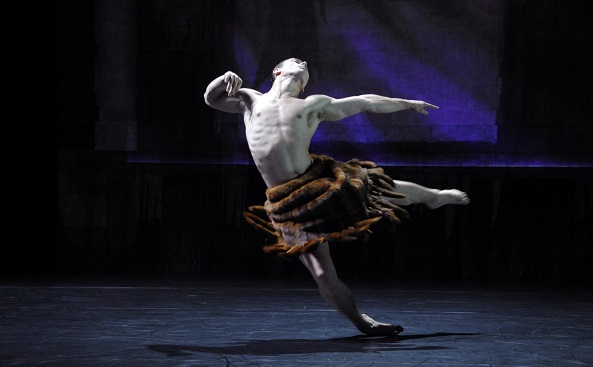Dunstan Playhouse, Adelaide
August 20, 2014
By Rachel Kennedy of Dance Informa.
Entering the theatre I was struck by the intense aroma of incense and immediately I was transported back to my childhood and memories of attending funerals in the Catholic Church. I felt a certain reverence as I took my seat in the auditorium. The atmosphere of the theatre had transformed from a casual evening out into an experience that was quite thought-provoking and sombre.
As the scent of incense dissipated, the audience filtered in and the usual pre-show rumbles could be heard. I wondered how on earth one man could do justice to such an indelible score of music and after such a long absence, what could Adelaide expect to see from Meryl Tankard?
The opening video display had quite an old-worldly eeriness to it. A combination of striking black and white close-ups of Paul White’s face and bird sounds, gunshots and church bells led into a stunning kaleidoscope of anatomical images accompanied by baroque music. I was absolutely mesmerized by the video, which continued to morph into a kind of medieval twilight zone.
These elements all set the stage for White’s stealth entrance. Even though he stepped onto the stage in the darkness you could feel his presence fill the entire space. The sounds of the old world faded and the intensely complex music of Stravinsky began to play.
In my mind, Tankard had a lot to live up to. I studied Pina Bausch’s The Rite of Spring in college and was fortunate enough to attend a performance of the work in Wuppertal, Germany in the early 1990s. Bausch’s powerful choreography combined with Stravinsky’s fierce score has had an everlasting impression on me.
Igor Stravinsky composed The Rite of Spring in the early 1900s. The music tells the story of a pagan ritual in which rival tribes dance together and choose a sacrificial virgin to dance herself to death. The ballet, originally choreographed by Vaslav Nijinsky, was considered extremely controversial at the time, causing riots at its premiere in Paris in 1913.
Nijinsky broke the classical ballet mould when he created The Rite of Spring. He used turned-in positions of the feet, parallel lines and stilted, forceful movement. This was a far cry from the flowing beauty of the ballet as it was at that time. The groundbreaking choreography, along with the pagan themes, were the catalyst for the outrage that occurred in Paris that night.

Paul White in ‘The Oracle’. Photo by Regis Lansac.
Whilst there were certainly no riots at the Dunstan Playhouse, I believe Meryl Tankard has succeeded in breaking the mould of a work so well-known by creating a masterful solo. The work manages to engulf the stage with as much energy as an entire company of dancers.
Echoes of Nijinsky’s tribal-like footwork were evident in Tankard and White’s choreography and the audience was taken on a journey of a ritual described by the movement, video, light and music.
Paul White moved across the stage with such strength and control, his effortless physicality was phenomenal. His body seemed to act as the conduit through which the story was told and the choreography had a compelling simplicity to it. We didn’t see much of his face so he relied solely on his body to convey the message of the work.
There were two outstanding images that have been replaying in my mind ever since. The first was the circle of light that surrounded White and expanded as he moved in and around the edges of it wearing only white underwear and a bonnet. The light appeared as if it were beaming down from a UFO and White seemed to be caught inside it. The light then vanished suddenly, giving the impression it had taken White up with it.
The other incredibly powerful image was a black and white projection of White’s torso on the video screen towards the end. As White closes his eyes, a set of eyeballs appear on his eyelids as if he could see everything through his eyelids. Once again, I felt like I was in the twilight zone.
There was a magical symbiosis between the dancer, the music, the video and the lighting. One could not have held the stage without the other. What was really interesting was the way in which the contrast of the darkness seemed to support his body throughout this gruelling solo.
The Sacrificial Dance was highly physical and arduous. White’s body was completely exposed and he seemed to be possessed by the dance. He struggled with it but he had no choice, it was a dance to the death.
There is no use in comparing The Oracle with any other version of The Rite of Spring. It stands alone as a monumental solo. Whilst I may have entered the theatre feeling contemplative, I left with a feeling of quiet awe and satisfaction. I am certain The Oracle will continue on its journey around the world, creating everlasting impressions for everyone who sees it.
Photo (top): Paul White in The Oracle. Photo by Regis Lansac.

















